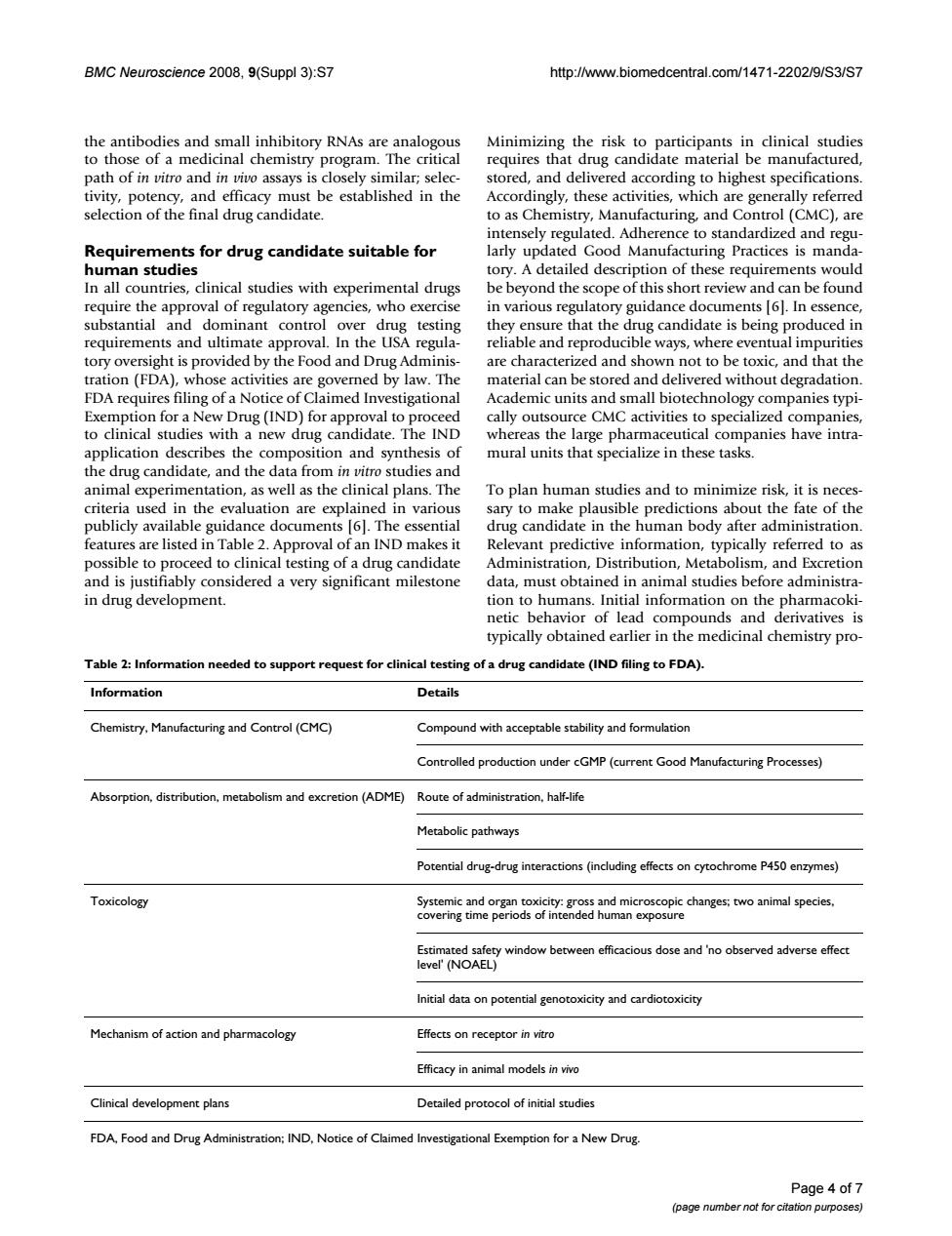正在加载图片...

BMC.9(Suppl 3):S7 http://www.biomedcentral.com/1471-2202/9/S3/S7 ath of nndays is closelysma stored,and delivered according to highest specifications es,wh are gen Requirements for drug candidate suitable for ood Manuta ing Practices is man In al stu clinical studies with experimental drug nd th require the approval of regulatory agencies,who exercise n various regulatory guidance documents 6.In essence substantial and dominant contro ight is ed and sho ot to h nd that the tration (FDA)whose activities are govemed by law.The material can be stored and delivered without degradation. FDA requires filing of a Notice of C Claimed Investigationa whereas the laree application describes the composition and synthesis of mural units that specialize in these tasks l8andidhate,andthedh the tudies an isk.it crite on as well the clin plan humar To es and t minimi publicly available guidance documents 6].The essentia r administration featurcs.arelistedinThable ed a v data.must obtai e ed in in drug development io 8amas,ianfomaiononheph9macok istry pro Table 2:Information needed to support request for clinical testing ofa drug candidate(IND filing to FDA). Information Details Chemistry.Manufacturing and Control (CMC) Compound with acceptable stability and formulation Absorption,distribution,metabolism and excretion (ADME) Route of administration Metabolic pathways Potential drug-drug (P450ym) Initiaatan potential genotoxicyand cardiotoxicity Mechanism of action and pharma Effects on receptor Clinical development plans Detailed protocol of initial studies FDA Food and Drug IND,Notice of Claimed foraNew Drug Page 4 of7 (page number not for citation purposes) BMC Neuroscience 2008, 9(Suppl 3):S7 http://www.biomedcentral.com/1471-2202/9/S3/S7 Page 4 of 7 (page number not for citation purposes) the antibodies and small inhibitory RNAs are analogous to those of a medicinal chemistry program. The critical path of in vitro and in vivo assays is closely similar; selectivity, potency, and efficacy must be established in the selection of the final drug candidate. Requirements for drug candidate suitable for human studies In all countries, clinical studies with experimental drugs require the approval of regulatory agencies, who exercise substantial and dominant control over drug testing requirements and ultimate approval. In the USA regulatory oversight is provided by the Food and Drug Administration (FDA), whose activities are governed by law. The FDA requires filing of a Notice of Claimed Investigational Exemption for a New Drug (IND) for approval to proceed to clinical studies with a new drug candidate. The IND application describes the composition and synthesis of the drug candidate, and the data from in vitro studies and animal experimentation, as well as the clinical plans. The criteria used in the evaluation are explained in various publicly available guidance documents [6]. The essential features are listed in Table 2. Approval of an IND makes it possible to proceed to clinical testing of a drug candidate and is justifiably considered a very significant milestone in drug development. Minimizing the risk to participants in clinical studies requires that drug candidate material be manufactured, stored, and delivered according to highest specifications. Accordingly, these activities, which are generally referred to as Chemistry, Manufacturing, and Control (CMC), are intensely regulated. Adherence to standardized and regularly updated Good Manufacturing Practices is mandatory. A detailed description of these requirements would be beyond the scope of this short review and can be found in various regulatory guidance documents [6]. In essence, they ensure that the drug candidate is being produced in reliable and reproducible ways, where eventual impurities are characterized and shown not to be toxic, and that the material can be stored and delivered without degradation. Academic units and small biotechnology companies typically outsource CMC activities to specialized companies, whereas the large pharmaceutical companies have intramural units that specialize in these tasks. To plan human studies and to minimize risk, it is necessary to make plausible predictions about the fate of the drug candidate in the human body after administration. Relevant predictive information, typically referred to as Administration, Distribution, Metabolism, and Excretion data, must obtained in animal studies before administration to humans. Initial information on the pharmacokinetic behavior of lead compounds and derivatives is typically obtained earlier in the medicinal chemistry proTable 2: Information needed to support request for clinical testing of a drug candidate (IND filing to FDA). Information Details Chemistry, Manufacturing and Control (CMC) Compound with acceptable stability and formulation Controlled production under cGMP (current Good Manufacturing Processes) Absorption, distribution, metabolism and excretion (ADME) Route of administration, half-life Metabolic pathways Potential drug-drug interactions (including effects on cytochrome P450 enzymes) Toxicology Systemic and organ toxicity: gross and microscopic changes; two animal species, covering time periods of intended human exposure Estimated safety window between efficacious dose and 'no observed adverse effect level' (NOAEL) Initial data on potential genotoxicity and cardiotoxicity Mechanism of action and pharmacology Effects on receptor in vitro Efficacy in animal models in vivo Clinical development plans Detailed protocol of initial studies FDA, Food and Drug Administration; IND, Notice of Claimed Investigational Exemption for a New Drug